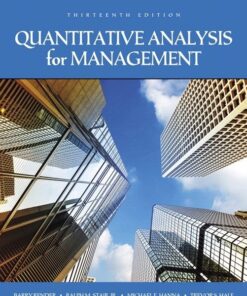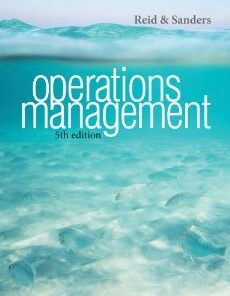Solution manual for Financial Institutions Management:A Risk Management Approach Saunders Cornett 8th edition
$35.00
Solution manual for Financial Institutions Management:A Risk Management Approach Saunders Cornett 8th edition
solutions manual Financial Institutions Management:A Risk Management Approach Saunders Cornett 8th edition
If you have any questions, or would like a receive a sample chapter before your purchase, please contact us at [email protected]
Table of Contents
Part I Introduction
Ch. 1 Why Are Financial Institutions Special?
Ch. 2 Financial Services: Depository Institutions
Ch. 3 Financial Services: Finance Companies
Ch. 4 Financial Services: Securities Brokerage and Investment Banking
Ch. 5 Financial Services: Mutual Funds and Hedge Funds
Ch. 6 Financial Services: Insurance
Ch. 7 Risks of Financial Institutions
Part II Measuring Risk
Ch. 8 Interest Rate Risk I
Ch. 9 Interest Rate Risk II
Ch. 10 Credit Risk: Individual Loan Risk
Ch. 11 Credit Risk: Loan Portfolio and Concentration Risk
Ch. 12 Liquidity Risk
Ch. 13 Foreign Exchange Risk
Ch. 14 Sovereign Risk
Ch. 15 Market Risk
Ch. 16 Off-Balance-Sheet Risk
Ch. 17 Technology and Other Operational Risks
Part III Managing Risk
Ch. 18 Liability and Liquidity Management
Ch. 19 Deposit Insurance and Other Liability Guarantees
Ch. 20 Capital Adequacy
Ch. 21 Product and Geographic Expansion
Ch. 22 Futures and Forwards
Ch. 23 Options, Caps, Floors, and Collars
Ch. 24 Swaps
Ch. 25 Loan Sales
Ch. 26 Securitization
Please note that the files are compressed using the program Winzip.
Files ending with the extension (.pdf) can be opened using Adobe Acrobat Reader.
Solutions for End-of-Chapter Questions and Problems: Chapter One
1. What are five risks common to all financial institutions?
Default or credit risk of assets, interest rate risk caused by maturity mismatches between assets and liabilities, liability withdrawal or liquidity risk, underwriting risk, and operating risks.
2. Explain how economic transactions between household savers of funds and corporate users of funds would occur in a world without financial institutions.
In a world without FIs the users of corporate funds in the economy would have to directly approach the household savers of funds in order to satisfy their borrowing needs. This process would be extremely costly because of the up-front information costs faced by potential lenders. Cost inefficiencies would arise with the identification of potential borrowers, the pooling of small savings into loans of sufficient size to finance corporate activities, and the assessment of risk and investment opportunities. Moreover, lenders would have to monitor the activities of borrowers over each loan’s life span. The net result would be an imperfect allocation of resources in an economy.
3. Identify and explain three economic disincentives that would dampen the flow of funds between household savers of funds and corporate users of funds in an economic world without financial institutions.
Investors generally are averse to directly purchasing securities because of (a) monitoring costs, (b) liquidity costs, and (c) price risk. Monitoring the activities of borrowers requires extensive time, expense, and expertise. As a result, households would prefer to leave this activity to others, and by definition, the resulting lack of monitoring would increase the riskiness of investing in corporate debt and equity markets. The long-term nature of corporate equity and debt securities would likely eliminate at least a portion of those households willing to lend money, as the preference of many for near-cash liquidity would dominate the extra returns which may be available. Finally, the price risk of transactions on the secondary markets would increase without the information flows and services generated by high volume.
4. Identify and explain the two functions FIs perform that would enable the smooth flow of funds from household savers to corporate users.
FIs serve as conduits between users and savers of funds by providing a brokerage function and by engaging in an asset transformation function. The brokerage function can benefit both savers and users of funds and can vary according to the firm. FIs may provide only transaction services, such as discount brokerages, or they also may offer advisory services which help reduce information costs, such as full-line firms like Merrill Lynch. The asset transformation function is accomplished by issuing their own securities, such as deposits and insurance policies that are more attractive to household savers, and using the proceeds to purchase the primary securities of corporations. Thus, FIs take on the costs associated with the purchase of securities.
?
5. In what sense are the financial claims of FIs considered secondary securities, while the financial claims of commercial corporations are considered primary securities? How does the transformation process, or intermediation, reduce the risk, or economic disincentives, to the savers?
Funds raised by the financial claims issued by commercial corporations are used to invest in real assets. These financial claims, which are considered primary securities, are purchased by FIs whose financial claims therefore are considered secondary securities. Savers who invest in the financial claims of FIs are indirectly investing in the primary securities of commercial corporations. However, the information gathering and evaluation expenses, monitoring expenses, liquidity costs, and price risk of placing the investments directly with the commercial corporation are reduced because of the efficiencies of the FI.
6. Explain how financial institutions act as delegated monitors. What secondary benefits often accrue to the entire financial system because of this monitoring process?
By putting excess funds into financial institutions, individual investors give to the FIs the responsibility of deciding who should receive the money and of ensuring that the money is utilized properly by the borrower. In this sense, depositors have delegated the FI to act as a monitor on their behalf. Further, the FI can collect information more efficiently than individual investors. The FI can utilize this information to create new products, such as commercial loans, that continually update the information pool. This more frequent monitoring process sends important informational signals to other participants in the market, a process that reduces information imperfection and asymmetry between the ultimate providers and users of funds in the economy.
7. What are five general areas of FI specialness that are caused by providing various services to sectors of the economy?
First, FIs collect and process information more efficiently than individual savers. Second, FIs provide secondary claims to household savers which often have better liquidity characteristics than primary securities such as equities and bonds. Third, by diversifying the asset base FIs provide secondary securities with lower price risk conditions than primary securities. Fourth, FIs provide economies of scale in transaction costs because assets are purchased in larger amounts. Finally, FIs provide maturity intermediation to the economy which allows the introduction of additional types of investment contracts, such as mortgage loans, that are financed with short-term deposits.
8. What are agency costs? How do FIs solve the information and related agency costs experienced when household savers invest directly in securities issued by corporations?
Agency costs occur when owners or managers take actions that are not in the best interests of the equity investor or lender. These costs typically result from the failure to adequately monitor the activities of the borrower. If no other lender performs these tasks, the lender is subject to agency costs as the firm may not satisfy the covenants in the lending agreement. Because the FI invests
?
the funds of many small savers, the FI has a greater incentive to collect information and monitor the activities of the borrower.
9. How do large financial institutions solve the problem of high information collection costs for lenders, borrowers, and financial markets?
One way financial institutions solve this problem is that they develop of secondary securities that allow for improvements in the monitoring process. An example is the bank loan that is renewed more quickly than long-term debt. The renewal process updates the financial and operating information of the firm more frequently, thereby reducing the need for restrictive bond covenants that may be difficult and costly to implement.
10. How do FIs alleviate the problem of liquidity risk faced by investors who wish to buy securities issued by corporations?
Liquidity risk occurs when savers are not able to sell their securities on demand. Commercial banks, for example, offer deposits that can be withdrawn at any time. Yet, the banks make long-term loans or invest in illiquid assets because they are able to diversify their portfolios and better monitor the performance of firms that have borrowed or issued securities. Thus, individual investors are able to realize the benefits of investing in primary assets without accepting the liquidity risk of direct investment.
11. How do financial institutions help individual savers diversify their portfolio risks? Which type of financial institution is best able to achieve this goal?
Money placed in any financial institution will result in a claim on a more diversified portfolio. Banks lend money to many different types of corporate, consumer, and government customers. Insurance companies have investments in many different types of assets. Investments in a mutual fund may generate the greatest diversification benefit because of the fund’s investment in a wide array of stocks and fixed income securities.
12. How can financial institutions invest in high-risk assets with funding provided by low-risk liabilities from savers?
Diversification of risk occurs with investments in assets whose returns are not perfectly positively correlated. One result of extensive diversification is that the average risk of the asset base of an FI will be less than the average risk of the assets in which the individual has invested. Thus, individual investors realize some of the returns of high-risk assets without accepting the corresponding risk characteristics.
13. How can individual savers use financial institutions to reduce the transaction costs of investing in financial assets?
By pooling the assets of many small investors, FIs can gain economies of scale in transaction costs. This benefit occurs whether the FI is lending to a corporate or retail customer, or purchasing assets in the money and capital markets. In either case, operating activities that are
designed to deal in large volumes typically are more efficient than those activities designed for small volumes.
14. What is maturity intermediation? What are some of the ways in which the risks of maturity intermediation are managed by financial institutions?
If net borrowers and net lenders have different optimal time horizons, FIs can service both sectors by matching their asset and liability maturities through on- and off-balance sheet hedging activities and flexible access to the financial markets. For example, the FI can offer the relatively short-term liabilities desired by households and also satisfy the demand for long-term loans such as home mortgages. By investing in a portfolio of long- and short-term assets that have variable- and fixed-rate components, the FI can reduce maturity risk exposure by utilizing liabilities that have similar variable- and fixed-rate characteristics, or by using futures, options, swaps, and other derivative products.
15. What are five areas of institution-specific FI specialness and which types of institutions are most likely to be the service providers?
First, commercial banks and other depository institutions are key players for the transmission of monetary policy from the central bank to the rest of the economy. Second, specific FIs often are identified as the major source of financing for certain sectors of the economy. For example, savings institutions traditionally serve the credit needs of the residential real estate market. Third, life insurance companies and pension funds commonly are encouraged to provide mechanisms to transfer wealth across generations. Fourth, depository institutions efficiently provide payment services to benefit the economy. Finally, mutual funds provide denomination intermediation by allowing small investors to purchase pieces of assets with large minimum sizes such as negotiable CDs and commercial paper issues.
16. How do depository institutions such as commercial banks assist in the implementation and transmission of monetary policy?
The Federal Reserve Board can directly involve commercial banks in the implementation of monetary policy through changes in the reserve requirements and the discount rate. The open market sale and purchase of Treasury securities by the Fed involves banks in the implementation of monetary policy in a less direct manner.
17. What is meant by credit allocation regulation? What social benefit is this type of regulation intended to provide?
Credit allocation regulation refers to the requirement faced by FIs to lend to certain sectors of the economy which are considered to be socially important. These may include housing and farming. Presumably the provision of credit to make houses more affordable or farms more viable leads to a more stable and productive society.
?
18. Which intermediaries best fulfill the intergenerational wealth transfer function? What is this wealth transfer process?
Life insurance companies and pension funds often receive special taxation relief and other subsidies to assist in the transfer of wealth from one generation to another. In effect, the wealth transfer process allows for the accumulation of wealth by one generation to be transferred directly to one or more younger generations by establishing life insurance policies and trust provisions in pension plans. Often this wealth transfer process avoids the full marginal tax treatment that a direct payment would incur.
19. What are two of the most important payment services provided by financial institutions? To what extent do these services efficiently provide benefits to the economy?
The two most important payment services are check clearing and wire transfer services. Any breakdown in these systems would produce gridlock in the payment system with resulting harmful effects to the economy at both the domestic and potentially the international level.
20. What is denomination intermediation? How do FIs assist in this process?
Denomination intermediation is the process whereby small investors are able to purchase pieces of assets that normally are sold only in large denominations. Individual savers often invest small amounts in mutual funds. The mutual funds pool these small amounts and purchase a well diversified portfolio of assets. Therefore, small investors can benefit in the returns and low risk which these assets typically offer.
21. What is negative externality? In what ways do the existence of negative externalities justify the extra regulatory attention received by financial institutions?
A negative externality refers to the action by one party that has an adverse effect on another party who is not part of the original transaction. For example, in an industrial setting, smoke from a factory that lowers surrounding property values may be viewed as a negative externality. For financial institutions, one concern is the contagion effect that can arise when the failure of one FI can cast doubt on the solvency of other FIs.
22. If financial markets operated perfectly and costlessly, would there be a need for financial institutions?
To a certain extent, financial institutions exist because of financial market imperfections. If information is available costlessly to all participants, savers would not need FIs to act as either their brokers or their delegated monitors. However, if there are social benefits to intermediation, such as the transmission of monetary policy or credit allocation, then FIs would exist even in the absence of financial market imperfections.
?
Be the first to review “Solution manual for Financial Institutions Management:A Risk Management Approach Saunders Cornett 8th edition” Cancel reply
Related products
Solution Manual
Solution manual for Engineering Mechanics: Dynamics Costanzo Plesha Gray 2nd edition
Solution Manual
Organizational Behavior Robbins 15th Edition Solutions Manual
Solution Manual
Solution Manual for An Introduction to Mechanics 2nd Edition












Reviews
There are no reviews yet.